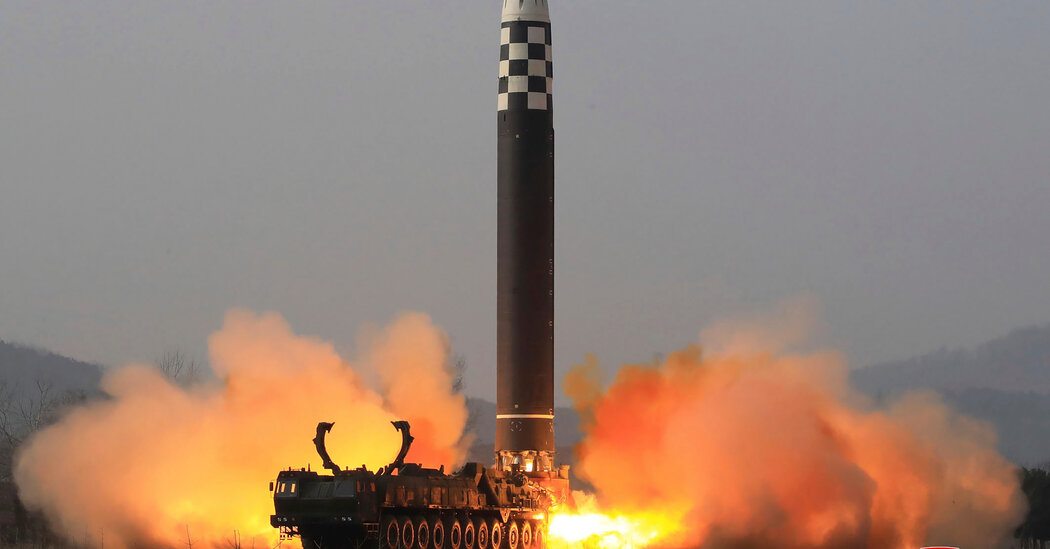
SEOUL — When North Korea conducted its most powerful intercontinental ballistic missile test to date last week, it said it launched the Hwasong-17, its newest and biggest ICBM. In a propaganda blitz, the country’s state media released a Hollywood-style video of its leader, Kim Jong-un, personally guiding the test launch in a sleek leather jacket and sunglasses at Pyongyang International Airport.
South Korea now says it may have been a ruse.
In a report to the National Assembly on Tuesday, the South Korean Defense Ministry endorsed what some analysts had already suspected: North Korea actually fired its older Hwasong-15 ICBM — which was tested in 2017 — and exaggerated Mr. Kim’s weapons achievements by falsely claiming a successful Hwasong-17 launch.
Mr. Kim badly needs to strengthen his diplomatic leverage with the United States and South Korea, and a successful new launch may have helped. But more important, South Korean officials said, Mr. Kim used the launch and a crude, fake presentation of video and photos to demonstrate his infallible leadership to the long-suffering people of North Korea.
The country will celebrate the 110th birthday of Kim Il-sung, Mr. Kim’s grandfather and North Korea’s founder, next month. With his economy hobbled by international sanctions and the pandemic, Mr. Kim has often used such occasions to focus on his growing nuclear capabilities and to show off his power.
“We suspect the latest launch had more to do with domestic considerations,” the Defense Ministry said in its parliamentary report.
When North Korea first unveiled the Hwasong-17 during a military parade in October 2020, it appeared to be the largest mobile-launcher ICBM the world had ever seen. Some analysts suspected that, unlike the Hwasong-15, which is built to carry a single warhead, the Hwasong-17 appeared to be designed to carry multiple nuclear warheads. A successful launch would have marked a significant milestone in North Korea’s ICBM program.
North Korea began testing the Hwasong-17 this year. On Feb. 27 and March 5, it tested the missile’s first-stage booster rocket and other components, but not at full range. In its third test, conducted on March 16, something went wrong, and the rocket exploded in the sky near Pyongyang, the capital, shortly after liftoff.
“The explosion was visible to the naked eye, as its debris rained down through the sky over Pyongyang,” Ha Tae-keung, a South Korean lawmaker, told reporters this week. “Pyongyang citizens were shocked, and it could even have led to some instability.” South Korean officials said Mr. Kim likely used the successful test flight of the Hwasong-15 disguised as the Hwasong-17 on March 24 as damage control.
“Now that Pyongyang citizens had witnessed the failure, they needed to send a message of success and do so quickly in order to prevent rumors from spreading and to ensure regime stability,” the Defense Ministry said in its parliamentary report. “So they launched a Hwasong-15 model whose reliability had been confirmed through a test in 2017.”
The Hwasong-17 is bigger and longer than the Hwasong-15. Its first-stage booster rocket has four nozzles, while the Hwasong-15 has only two. But Mr. Kim’s propagandists edited and combined video footage and photos from the earlier Hwasong-17 tests with those from the Hwasong-15 last Thursday, creating the illusion of a successful Hwasong-17 launch, South Korean officials said.
While unsuspecting North Koreans may have been fooled, the alleged fakery did not escape the scrutiny of South Korean defense officials and private analysts.
The weather around Pyongyang last Thursday was overcast, but some photos of the test released by North Korean media showed a fine and clear day. The test took place in the afternoon, but in some photos and video footage, the shadow of Mr. Kim at the test site suggests that he was inspecting a test in the morning. (All three previous Hwasong-17 tests, including the one that failed, took place in the morning.)
The engine burn time and trajectory data from the test also hinted at a Hwasong-15 rather than the Hwasong-17, South Korean officials said. And lastly, satellite and other data indicated that the missile had two nozzles, not four, officials said.
With no free news media allowed in North Korea, it is extremely difficult to verify official claims independently. When North Korea conducts a weapons test like the one last Thursday, outside analysts have few sources of information other than North Korean state media and a small amount of data released from Seoul or Tokyo. And in North Korea, propaganda routinely trumps the truth.
The Significance of North Korea’s Missile Tests
Still, it is unusual for the South Korean military to dispute a North Korean claim so publicly and with so much detail. Some analysts say the South Korean military has a history of downplaying the power of its Northern rival.
The South Korean military may also have been particularly upset by the launch because it came in the middle of a rocky presidential transition in Seoul: President-elect Yoon Suk-yeol told the Defense Ministry to move out of its current location so he could use it for his presidential office after his inauguration on May 10.
Hwasong-17 or not, the North’s latest missile launch still violated U.N. resolutions and the country’s self-imposed moratorium on ICBM tests. It also demonstrated significant technological advances. The missile soared 3,852 miles into space, compared with an altitude of 2,796 miles that the Hwasong-15 achieved in its last test in November 2017.
The main question appears to be whether the weapon was an improved and more powerful version of the Hwasong-15 or the same Hwasong-15 equipped with more fuel and a lighter payload allowing it to fly higher.
“We should not pay too much attention to whether this was a Hwasong-15 or 17,” said Kim Dong-yup, an expert on the North Korean military at the University of North Korean Studies in Seoul. “I don’t think you can generate such flight data by just reducing the payload or using a little more fuel. This clearly marks a technological advance.”




